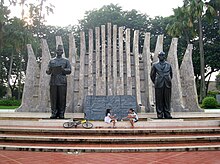
Sukarno was an Indonesian statesman, orator, revolutionary, and nationalist who was the first president of Indonesia, serving from 1945 to 1967.
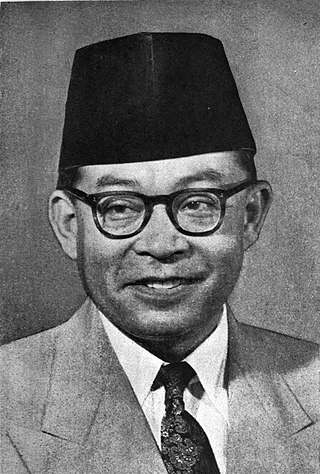
Mohammad Hatta was an Indonesian statesman, nationalist, and independence activist who served as the country's first vice president. Known as "The Proclamator", he and a number of Indonesians, including the first president of Indonesia, Sukarno, fought for the independence of Indonesia from the Netherlands. Hatta was an important figure during the Indonesian national awakening and during the national revolution, as a youth he was politically active both in the Netherlands and the Indies, which led him to be imprisoned in the Boven Digoel concentration camp for his activism, he also played a crucial part in the proclamation of Indonesian independence, being second the person to sign the declaration besides Sukarno, thus naming him as one of the founders of Indonesia.
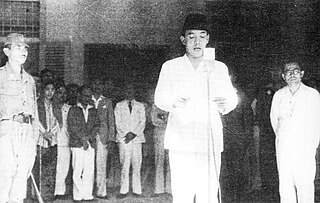
The Proclamation of Indonesian Independence was read at 10:00 on Friday, 17 August 1945 in Jakarta. The declaration marked the start of the diplomatic and armed resistance of the Indonesian National Revolution, fighting against the forces of the Netherlands and pro-Dutch civilians, until the latter officially acknowledged Indonesia's independence in 1949. The document was signed by Sukarno and Mohammad Hatta, who were appointed president and vice-president respectively the following day.

Sutan Sjahrir was an Indonesian politician, and revolutionary independence leader, who served as the first Prime Minister of Indonesia, from 1945 until 1947. Previously, he was a key Indonesian nationalist organizer in the 1930s and 1940s. Unlike some of his colleagues, he did not support the Japanese during the Japanese occupation and fought in the resistance against them. He was considered to be an idealist and an intellectual.

Menteng is a district in the administrative city of Central Jakarta, Indonesia. Menteng is surrounded by the districts of Senen and Matraman to the east, Tebet and Setiabudi to the south, Tanah Abang to the west, and Gambir to the north. Menteng is bound by the West Flood Canal to the west, Ciliwung River to the south and east, and Kebon Sirih Road to the north. Menteng is the district seat of the Central Jakarta government.

Mohamad Ibnu Sayuti, known as Sayuti Melik was an Indonesian typist. He helped type a copy of the Proclamation of Indonesian Independence, which Sukarno proclaimed to Indonesia on 17 August 1945. He was the husband of Soerastri Karma Trimurti, a journalist and activist in the women's rights and Indonesian independence movements.

The Third Sjahrir Cabinet was the fourth Indonesian cabinet. It served from October 1946 to June 1947, when it fell due to disagreements related to the implementation of the Linggadjati Agreement and subsequent negotiations with the Dutch.

Selamat Datang Monument, also known as the Monumen Bundaran HI or Monumen Bunderan HI, is a monument located in Central Jakarta, Indonesia. Completed in 1962 by sculptor Edhi Sunarso, the Selamat Datang Monument is one of the historic landmarks of Jakarta.
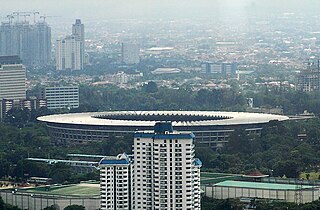
Bung Karno Sports Arena, formerly named Senayan Sports Arena from 1969 to 2001 and Asian Games Complex on its early days, is a sports complex located in Gelora, Central Jakarta, Indonesia. It is usually misperceived to be located at Senayan, South Jakarta, hence its former name. The sports complex hosts main stadium, secondary stadium, the Sports Palace, football fields, aquatic stadium, tennis stadiums, hockey, baseball and archery fields, and several indoor gymnasiums. The complex was built in 1960 for the 1962 Asian Games and recently underwent a major reconstruction for the 2018 Asian Games and Asian Para Games.

The Formulation of Proclamation Text Museum is a history museum in Jakarta, Indonesia. The building is where the Proclamation of Indonesian Independence was formulated.
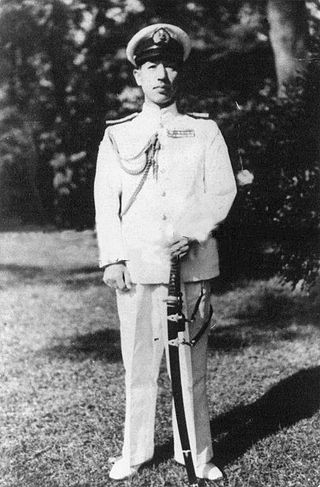
Rear Admiral Tadashi Maeda was a high-ranking Imperial Japanese Navy officer during the Pacific War. Maeda played an important role in Indonesian independence; he met Sukarno and Mohammad Hatta at his house in Jakarta on 16 August 1945 and his house was used for drafting the Proclamation of Indonesian Independence. After leaving military service, Maeda worked in the oil industry.

The Gedung Agung is one of six presidential palaces of Indonesia, it is located in the city of Yogyakarta. The palace complex covers an area of approximately 4.4 hectares. It is located in front of Fort Vredeburg.

Wikana was an Indonesian minister and independence leader. He was one of the youths who forced Sukarno and Hatta to declare independence immediately after the surrender of the Japanese. He was the first Indonesian Minister of Youth and Sport. He was a member of the Indonesian Communist Party. Sometime after the 1965 coup d'état attempt, he was arrested and went missing, it is supposed that he was one of the assassinated in the Indonesian mass killings of 1965–66.

Sukarni Kartodiwirjo was an Indonesian freedom fighter and activist who demanded independence for Indonesia during the Dutch colonial era and the Japanese occupation, and was the chairman of the Murba Party until his death.
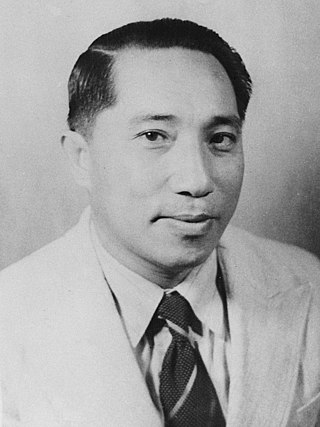
Herling Laoh was an Indonesian bureaucrat and engineer. A member of the Indonesian National Party (PNI), Laoh served as minister of public works (1947–1950) and minister of transportation (1949–1950). Born to a goldsmith and his wife in present-day North Sulawesi, he studied civil engineering at the Technische Hoogeschool te Bandoeng (THB). After graduating in 1928, he worked as an engineer in various construction projects. Following the Proclamation of Indonesian Independence in 1945, he joined the PNI and served as a minister in several cabinets. He was later involved in PRRI/Permesta rebellion, becoming a state minister in the rebel government.
Johanna Tumbuan Masdani, also known as Jo Masdani, was a pioneering figure in Indonesian independence. She was born Johanna Tumbuan in Amurang, in the region of Minahasa in North Sulawesi. She was present during two important events in Indonesian history, namely the Youth Pledge during the Second Youth Congress in 1928 and the Proclamation of Indonesian Independence in 1945. She graduated and taught in the Faculty of Psychology at the University of Indonesia.

The Rengasdengklok Incident was the kidnapping of Sukarno and Hatta by several youths (pemuda) at around 4 am on August 16, 1945 to persuade the two men to declare Indonesian independence. It was the peak of the disagreement between the older and pemuda groups over how to carry out the proclamation of independence.

Burhanuddin Mohammad Diah, born only as Burhanuddin, was an Indonesian journalist, diplomat, and businessman, who served as the 18th Indonesian Minister of Information from 1966 until 1968, under the presidencies of Sukarno and Suharto, during the transition to the New Order. He was present at the time of the Proclamation of Independence was being formulated, and was a figure who played an important role in saving the original text of the Proclamation.
Gedung Joang '45 is a historical museum in Jakarta, which tells the history of the Indonesian struggle for independence from Dutch colonial rule and the formation of the state of Indonesia.

I Nyoman Nuarta is an Indonesian sculptor and artist who created a number of monuments across Indonesia.
